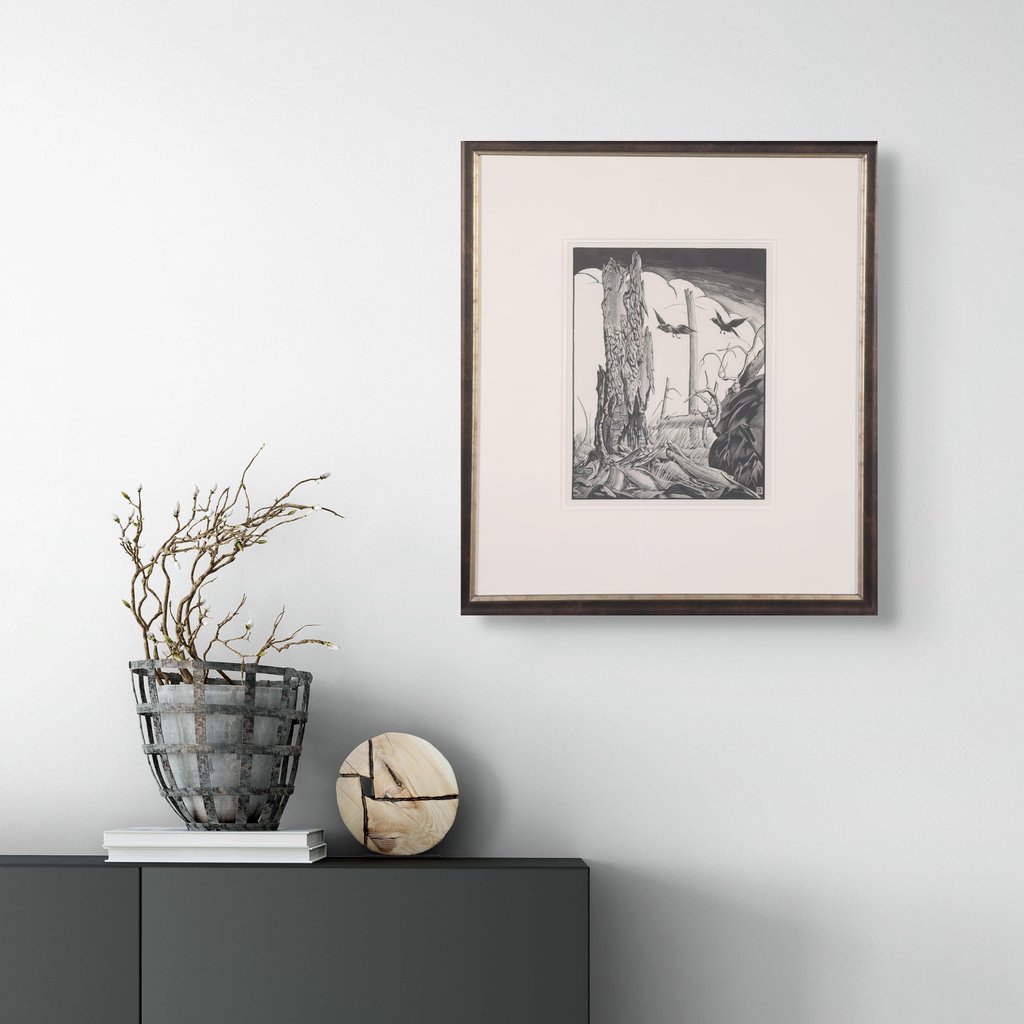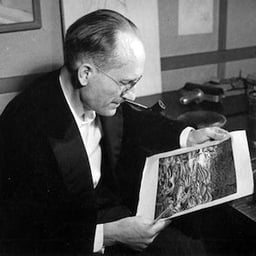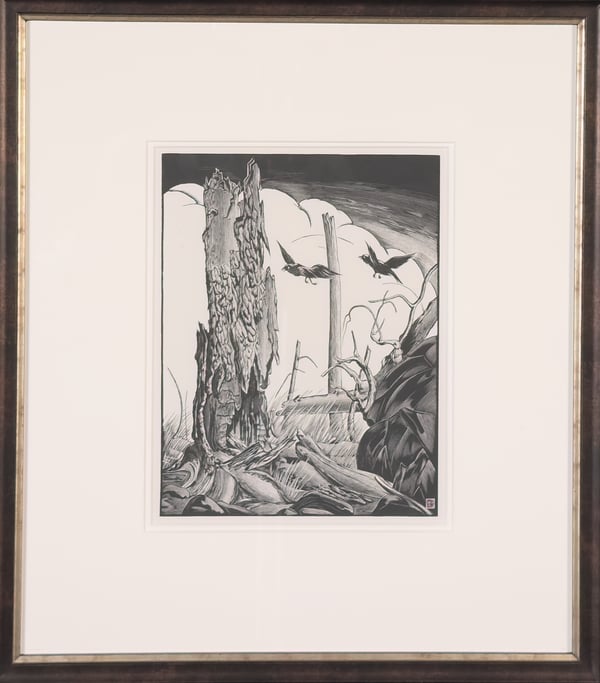Untitled (Black Birds & Stump)
16.25 x 14.25 in (41.3 x 36.2 cm) including frame
(Includes Buyer's Premium)


Henry Eric Bergman
CSGA, CSPWC, MSA

Henry Eric Bergman was a Canadian artist known for his mastery of wood engraving, a technique he refined over decades of dedicated practice. Born in Dresden, Germany, as Heinrich Erich Bergmann, he received formal training at the Art and Trade School of Dresden, earning a Diploma of Merit in 1911. His early career was rooted in commercial wood engraving, primarily for catalog illustration. In 1913, Bergman immigrated to Canada and soon after settled in Winnipeg, Manitoba, where he joined Brigden's Limited, a prominent engraving firm. There, he worked on commercial projects, including engraving for the Eaton's catalogue, while gradually developing his fine art practice.
Encouraged by fellow artists Frederick H. Brigden and Walter J. Phillips, Bergman began to explore printmaking as an artistic pursuit. By the mid-1920s, he had produced his first wood engravings, a medium that would become his primary focus. He abandoned colour woodblock printing in favour of the monochromatic precision of wood engraving, allowing for intricate detail and subtle tonal variations. His subject matter ranged from landscapes and urban scenes to botanical studies, often reflecting a deep appreciation for nature and the Canadian environment. His work was known for its fine craftsmanship, clarity of line, and an ability to convey depth and texture with remarkable precision.
Bergman gained national and international recognition, exhibiting regularly with the Manitoba Society of Artists, the Royal Canadian Academy, and the Society of Canadian Painter-Etchers and Engravers, of which he was a past president. His work appeared in international print exhibitions, and special editions of The Studio featured his engravings in 1927 and 1930. In 1947, his engravings illustrated James A. Roy's book "The Heart is Highland," further cementing his reputation as a skilled printmaker. He was also a charter member of the Winnipeg Art Gallery and an active participant in the Canadian Handicrafts Guild.
Bergman’s engravings from the 1930s and 1940s are considered among his finest works. During this period, he created highly detailed plant studies and atmospheric landscapes that captured the quiet beauty of rural and urban Canadian settings. His later years were dedicated almost exclusively to botanical subjects, which were widely acclaimed for their precision and delicacy. Despite his relatively small output, with most of his editions remaining incomplete, Bergman’s prints remain highly sought after, often appearing in public gallery collections and private holdings.
Beyond his artistic contributions, Bergman was a key figure in Winnipeg’s cultural landscape, fostering the development of printmaking in Canada. His meticulous approach to wood engraving helped preserve and advance the tradition of the medium at a time when commercial wood engraving was becoming obsolete. His legacy endures through his work held in major Canadian institutions, including the Winnipeg Art Gallery, the National Gallery of Canada, and the Glenbow Museum.
Henry Eric Bergman passed away in Winnipeg on February 9, 1958. His work continues to be recognized for its technical excellence and artistic sensitivity, marking him as one of Canada’s foremost printmakers of the early 20th century.
March Canadian Fine Art Auction
March 13 - March 27, 2025
212 McDermot Ave, Winnipeg MB
(204) 255-5690
mayberryfineart.com
[email protected]
Contact us to make an appointment to preview this item or to sell similar works.
|
Bidding Range
|
Increment
|
|---|---|
| $0.00 - $50.00 | $1.00 |
| $50.00 - $100.00 | $5.00 |
| $100.00 - $500.00 | $10.00 |
| $500.00 - $1,000.00 | $25.00 |
| $1,000.00 - $5,000.00 | $50.00 |
| $5,000.00 - $10,000.00 | $100.00 |
| $10,000.00 - $20,000.00 | $200.00 |
| $20,000.00 - $50,000.00 | $500.00 |
| $50,000.00 - $100,000.00 | $1,000.00 |
| $100,000.00+ | $5,000.00 |
Login or register a BidLots.com account to participate in any auction. Track specific lots and artists with real-time notifications on all bidding activity.
Bidding approval requires three simple steps:
1. Create a Bid Lots account
2. Confirm your email address
3. Create a valid billing profile
Bid Lots and/or the auctioneer may choose to revoke your bidding privileges if your account is not in good standing or your activity is in conflict with our standard terms and conditions of sale.
The buyer’s premium is an additional percentage charged to the winning bidder. The buyer’s premiums may vary from auction to auction, typically ranging from 10% to 20%. Buyer’s premiums will be displayed on detailed lot listings and paddle registration forms.
Bidding begins at the reserve price and advances at set increments based on the bidding range. The specific bidding increments may vary from auction to auction, however the next bid and subsequent increments will always be clearly defined on detailed lot listings. Maximum Bids and Single Bids can only be placed within the pre-defined bidding increments ensuring that no two bidders can place identical bids on an item. View individual lot detail pages to see a complete range of bidding increments for that item.
Requests to cancel a single bid are at the sole descretion of the auctioneer. Maximum bids can be increased but cannot be decreased unless premitted by the auctioneer. Requests to cancel a bid or to alter a maximum bid will be denied if the specific lot is scheduled to close in less than 24 hours or if the lot has significant interest or activity.
To request that a bid be cancelled or to change a maximum bid use the "Ask a question" button on the detailed lot listing.
You will receive an email notification when you have successfully won an auction. You will also see the item listed on your "Bidding Results" page and if you are logged into the site you will see a highlighted message on the auction catalogue pages and auction listings.
Shipping requirements may vary on different items depending on location and size or weight of an item. When registering for a specific auction you will be provided options to clarify your preferred shipping instructions. The auctioneer will also review and provide specific shipping quotes or options following the close of an auction. If you have specific shipping requirements or are unsure of the shipping constraints on a specific item please contact the auctioneer prior to bidding.
Following the close of an auction the auctioneer will provide a detailed invoice for all items you have won. They may contact you before a final invoice is prepared to confirm or review specific shipping instructions. Payment is due once a final invoice is provided and can be submitted online by credit card, or made by EFT (Electronic Fund Transfer), bank draft or international wire transfer. Any outstanding balance will be automatically charged to your registered credit card 5 days following the close of an auction.


